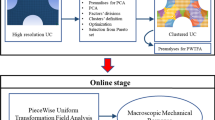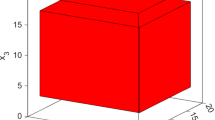Abstract
In contrast to the classical local theories, the peridynamic equation of motion introduced by Silling (J Mech Phys Solids 48:175–209, 2000) is free of any spatial derivatives of the displacement field. A theory of thermoelastic composite materials (CMs) with nonlocal peridynamic properties of multiphase constituents of arbitrary geometry is analyzed for periodic structure CMs subjected to the volumetric periodic boundary conditions. At first, we consider a linear thermoelastic problem for perydynamics CMs. Effective properties of peridynamic CM are expressed through the introduced micro polarization tensor averaged over the extended inclusion phase. Decompositions of material and field parameters are performed for analysis of the fields produced by both mechanical loading and eigenfield loading. Transformation field analysis (TFA) and clustering discretization method (defining offline linear stage) adapted to the linear peridynamic micromechanics are proposed (the novelty of the approach proposed) by the use of formal similarity of suggested methods with corresponding approaches of local micromechanics (LM). Stress and displacement in each cluster are assumed to be constant and linear functions, respectively, even when a cluster is not a simply connected area in general. This fact greatly reduces the degree of freedom in the problem being considered and leads to a greatly improved computational efficiency with their wide potential applications (e.g., in machine learning). The clustering version of TFA for the homogenization of nonlinear elastic peridynamic micromechanics (PM, online nonlinear stage) is based on employing eigenstrains to account for inelastic displacements arising from material nonlinearity. The scheme of numerical solution of linear thermoelastic peridynamic problem and estimation of influence functions are presented.



Similar content being viewed by others
Availability of Data and Materials
No any datasets used.
References
Silling S (2000) Reformulation of elasticity theory for discontinuities and long-range forces. J Mech Phys Solids 48:175–209
Madenci E, Oterkus E (2014) Peridynamic theory and its applications. Springer, NY
Silling SA, Lehoucq RB (2008) Convergence of peridynamics to classical elasticity theory. J Elasticity 93:13–37
Silling SA, Lehoucq RB (2010) Peridynamic theory of solid mechanics. Adv Appl Mech 44:73–168
Silling SA, Epton M, Weckner O, Xu J, Askari E (2007) Peridynamic states and constitutive modeling. J Elasticity 88:151–184
Buryachenko VA (2014) Some general representations in thermoperistatics of random structure composites. Int J Multiscale Comput Eng 12:331–350
Buryachenko VA (2017) Effective properties of thermoperistatic random structure composites: some background principles. Math Mech Solids 22:366–1386
Alali B, Lipton R (2012) Multiscale dynamics of heterogeneous media in the peridynamic formulation. J Elast 106:71–103
Diyaroglu C, Madenci E, Phan N (2019) Peridynamic homogenization of microstructures with orthotropic constituents in a finite element framework. Compos Struct 227:111334
Diyaroglu C, Madenci E, Stewart RJ, Zobi SS (2019) Combined peridynamic and finite element analyses for failure prediction in periodic and partially periodic perforated structures. Compos Struct 227:111481
Buryachenko VA (2024) Generalized Mori-Tanaka approach in peridynamic micromechanics of multilayered composites of random structure. J Peridyn Nonlocal Model. https://doi.org/10.1007/s42102-023-00114-8
Silling SA (2014) Origin and effect of nonlocality in a composite. J Mech Mater Struct 9:245–258
Xia W, Oterkus E, Oterkus S (2020) Peridynamic modeling of periodic microstructured materials Procedia Struct Integr 28:820–828
Buryachenko V (2019) Computational homogenization in linear elasticity of peristatic periodic structure composites. Math Mech Solids 24:2497–2525
Buryachenko VA (2022) Local and nonlocal micromechanics of heterogeneous materials. Springer, NY
Diyaroglu C, Madenci E, Phan N (2019) Peridynamic homogenization of microstructures with orthotropic constituents in a finite element framework. Compos Struct 227:111334
Dvorak G (1992) Transformation field analysis of inelastic composite materials. Proc R Soc Lond A 437:311–327
Dvorak GJ (2013) Micromechanics of composite materials. Springer, Dordrecht
Dvorak G, Bahei-El-Din Y, Wafa A (1994) The modeling of inelastic composite materials with the transformation field analysis. Model Simul Mater Sci Eng 2:571–586
Dvorak GJ, Benveniste Y (1992) On transformation strains and uniform fields in heterogeneous media. Proc R Soc Lond A 437:291–310
Benaimeche MA, Yvonnet J, Bary B, He Q-C (2022) A k-means clustering machine learning-based multiscale method for inelastic heterogeneous structures with internal variables. Int J Numer Methods Eng 123:2012–2041
Berkooz G, Holmes P, Lumley JL (1993) The proper orthogonal decomposition in the analysis of turbulent flows. Ann Rev Fluid Mech 25:539–575
Castrogiovanni A, Marfia S, Auricchio F, Sacco E (2021) TFA and HS based homogenization techniques for nonlinear composites. Int J Solids Struct 225:111050
Covezzi F, Miranda S, Marfia S, Sacco E (2017) Homogenization of elastic-viscoplastic composites by the mixed TFA. Comput Meth Appl Mech Eng 318:701–723
Covezzi F, Miranda S, Fritzen F, Marfia S, Sacco E (2018) Comparison of reduced order homogenization techniques: pRBMOR, NUTFA and MxTFA. Meccanica 53:1291–1312
Li H, Kafka OL, Gao J, Cheng Yu, Nie Y, Zhang L, Tajdari M, Shan Tang X, Guo GL et al (2019) Clustering discretization methods for generation of material performance databases in machine learning and design optimization. Comput Mech 64:281–305
Ri J-H, Hong H-S, Ri S-G (2021) Cluster-based nonuniform transformation field analysis: an efficient homogenization for inelastic heterogeneous materials. Int J Numer Methods Eng 122:4458–4485
Yvonnet J, He QC (2007) The reduced model multiscale method (R3M) for the non-linear homogenization of hyperelastic media at finite strains. J Comput Phys 223:341–368
Michel J, Suquet P (2003) Nonuniform transformation field analysis. Int J Solids Struct 40:6937–6955
Jain AK (2010) Data clustering: 50 years beyond K-means. Pattern Recognit Lett 31:651–666
Liu Z, Bessa MA, Liu WK (2016) Self-consistent clustering analysis: an efficient multi-scale scheme for inelastic heterogeneous materials. Comput Methods Appl Mech Eng. 306:319–41
Tang S, Zhang L, Liu WK (2018) From virtual clustering analysis to self-consistent clustering analysis: a mathematical study. Comput Mech 62:1443–1460
Liu Z, Fleming M, Liu WK (2018) Microstructural material database for self-consistent clustering analysis of elastoplastic strain softening materials. Comput Methods Appl Mech Eng 330:547–577
Kafka OL, Yu C, Shakoor M, Liu Z, Wagner GJ, Liu WK (2018) Data-driven mechanistic modeling of influence of microstructure on high-cycle fatigue life of nickel titanium. JOM, pp 1-5
Kilic B (2008) Peridynamic theory for progressive failure prediction in homogeneous and heterogeneous materials. Ph.D. Thesis, Dep Mechan Eng, The University of Arizona
Han X, Gao J, Fleming M, Chenghai X, Xie W, Meng S, Liu WK (2020) Efficient multiscale modeling for woven composites based on self-consistent clustering analysis. Comput Methods Appl Mech Eng 364:112929
Li H, Kafka OL, Gao J, Cheng Yu, Nie Y, Zhang L, Tajdari M, Shan Tang X, Guo GL et al (2019) Clustering discretization methods for generation of material performance databases in machine learning and design optimization. Comput Mech 64:281–305
Cheng G, Li X, Nie Y, Li H (2019) FEM-Cluster based reduction method for efficient numerical prediction of effective properties of heterogeneous material in nonlinear range. Comput Methods Appl Mech Eng 348:157–184
Liu Z, Fleming M, Liu WK (2018) Microstructural material database for self-consistent clustering analysis of elastoplastic strain softening materials. Comput Methods Appl Mech Eng 330:547–577
Ferreira BP, Pires FM, Bessa MA (2022) Adaptive clustering-based reduced-order modeling framework: fast and accurate modeling of localized history-dependent phenomena. Comput Methods Appl Mech Eng 393
Buryachenko V (2023) Transformation field analysis as a background of clustering discretization methods in micromechanics of composites. Math Mech Solids 28:2677–2703
Yu C, Kafka OL, Liu WK (2019) Self-consistent clustering analysis for multiscale modeling at finite strains Comput Meth Appl Mech Engng 349:339–359
Silling S (2011) A coarsening method for linear peridynamics. Int J Multiscale Comput Eng 9:609–622
Galadima Y, Oterkus E, Oterkus S (2019) Two-dimensional implementation of the coarsening method for linear peridynamics. AIMS Mater Sci 6:252–275
Bobaru F, Ha YD (2011) Adaptive refinement and multiscale modeling in 2D peridynamics. Int J Multiscale Comput Eng 9:635–659
Lehoucq RB, Silling SA (2008) Force flux and the peridynamic stress tensor. J Mech Phys Solids 56:1566–1577
Silling SA, Askari E (2005) A meshfree method based on the peridynamic model of solid mechanics. Comput Struct 83:1526–1535
Jafarzadeh S, Mousavi M, Larios A, Bobaru F (2022) A general and fast convolution-based method for peridynamics: applications to elasticity and brittle fracture. Comput Meth Appl Mech Eng 392
Bobaru F, Yang M, Alves LF, Silling SA, Askari A, Xu J (2009) Convergence, adaptive refinement, and scaling in 1d peridynamics. Int J Numer Methods Eng 77:852–877
Silling SA, Zimmermann M, Abeyaratne R (2003) Deformation of a peridynamic bar. J Elasticity 73:173–190
Weckner O, Abeyaratne R (2005) The effect of long-range forces on the dynamics of a bar. J Mech Phys Solids 53:705–728
Hu W, Ha YD, Bobaru F (2012) Peridynamic model for dynamic fracture in unidirectional fiber-reinforced composites. Comput Methods Appl Mech Eng 217–220:247–261
Emmrich E, Weckner O (2007) Analysis and numerical approximation of an integro-differential equation modeling non-local effects in linear elasticity. Math Mech Solids 12:363–384
Emmrich E, Weckner O (2007) On the well-posedness of the linear peridynamic model and its convergence towards the Navier equation of linear elasticity. Commun Math Sci 5:851–864
Silling SA, Lehoucq RB (2010) Peridynamic theory of solid mechanics. Adv Appl Mech 44:73–168
Macek RW, Silling SA (2007) Peridynamics via finite element analysis. Finite Elem Anal Des 43:1169–1178
Du Q, Gunzburger M, Lehoucq RB, Zhou K (2013) Analysis of the volume-constrained peridynamic Navier equation of linear elasticity. J Elast 113:193–217
Seleson P, Gunzburger M, Parks ML (2013) Interface problems in nonlocal diffusion and sharp transitions between local and nonlocal domains. Comput Methods Appl Mech Eng 266:185–204
Seleson P, Parks ML (2011) On the role of the influence function in the peridynamic theory. Int J Multiscale Comput Eng 9:689–706
Schmidhuber J (2015) Deep learning in neural networks: an overview. Neural Netw 61:85–117
Simo JC, Taylor RL (1986) A return mapping algorithm for plane stress elastoplasticity. Int J Numer Methods Eng 22:649–670
Guo K, Yang Z, Yu C-H, Buehler MJ (2021) Artificial intelligence and machine learning in design of mechanical materials Mater Horiz 8:1153–1172
Brunton SL, Kutz JN (2022) Data-driven science and engineering: machine learning, dynamical systems, and control. Cambridge University Press, Cambridge, UK
Yang H, Guo X, Tang S, Liu WK (2019) Derivation of heterogeneous material laws via data-driven principal component expansions. Comput Mech 64:365–379
Acknowledgements
The author acknowledges Dr. Stewart A. Silling for the fruitful personal discussions, encouragements, helpful comments, and suggestions. The author also acknowledges the reviewers for the encouraging comments that initiated a significant correction of the manuscript.
Author information
Authors and Affiliations
Contributions
VB wrote the all manuscript text.
Corresponding author
Ethics declarations
Ethical Approval
Applicable for both human and/ or animal studies. Ethical committees, Internal Review Boards, and guidelines followed must be named. When applicable, additional headings with statements on consent to participate and consent to publish are also required “not applicable”.
Competing Interests
The author declares no competing interests.
Additional information
Publisher's Note
Springer Nature remains neutral with regard to jurisdictional claims in published maps and institutional affiliations.
Rights and permissions
Springer Nature or its licensor (e.g. a society or other partner) holds exclusive rights to this article under a publishing agreement with the author(s) or other rightsholder(s); author self-archiving of the accepted manuscript version of this article is solely governed by the terms of such publishing agreement and applicable law.
About this article
Cite this article
Buryachenko, V.A. Transformation Field Analysis and Clustering Discretization Method in Peridynamic Micromechanics of Composites. J Peridyn Nonlocal Model (2024). https://doi.org/10.1007/s42102-023-00113-9
Received:
Accepted:
Published:
DOI: https://doi.org/10.1007/s42102-023-00113-9




